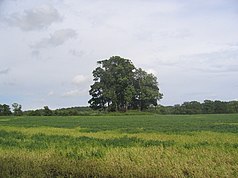Bjørn Farmann
| Bjørn Farmann | |||||
|---|---|---|---|---|---|
| King in Vestfold | |||||
| Reign | ?–? | ||||
| Coronation | none | ||||
| Predecessor | None | ||||
| Successor | Gudrød Bjørnsson | ||||
| Born | c.? Norway | ||||
| Died | c. 930–934 Norway | ||||
| Burial | |||||
| Wife |
| ||||
| Issue | Sons include: Gudrød Bjørnsson | ||||
| |||||
| Dynasty | Fairhair dynasty | ||||
| Father | Harald Fairhair | ||||
| Mother | Svanhild Eysteinsdottir | ||||
Bjørn Farmann( "Bjørn the Tradesman", also calledBjørn Haraldsson,FarmandandKaupman,died between 930 and 934) was a king ofVestfold.Bjørn was one of the sons of KingHarald Fairhairof Norway. In late tradition, Bjørn Farmann was made the great-grandfather ofOlaf II of Norway,through a sonGudrød Bjørnsson.
Biography
[edit]Bjørn Farmann was one of the sons born ofHarald Fairhairwith Svanhild, daughter ofEystein Earl.When Harald Fairhair died, his kingdom was divided up between his sons. Bjørn Farmann became the king ofVestfold,the county west of theOslofjord,and is considered as the founder ofTønsberg.Bjørn Farmann spent most of his time at the court at Sæheimr located nearSem, Norway.Erik Bloodaxe(Old Norse:Eiríkr blóðøx,Norwegian:Eirik Blodøks) was the eldest son of Harald Fairhair and became the second king of Norway (930–934). Once the power was in his hands, Erik Bloodaxe began to quarrel with his other brothers and had four of them killed, including Bjørn Farmann. Bjørn was killed byEirik Bloodaxein a feud around 930–934 AD atSæheimr.Later in battle atTønsberg,Erik Bloodaxe killedOlaf Haraldsson Geirstadalf,king ofVingulmarkand later also ofVestfoldtogether with Sigrød Haraldsson, king ofTrondheim.[1]

Farmannhaugen
[edit]Bjørn Farmann was reportedly killed by his brother King Eirik Bloodaxe at the Sæheimr estate. He is said to be buried inFarmannshaugen(from theOld Norsewordhaugrmeaning burial mound), outside Tønsberg about 3 km east of the village ofSem,close to the manor of theJarlsbergfamily. Farmannhaugen is visible from route 312. Farmannhaugen was archaeologically investigated during 1917.[2]
Snorri Sturluson
[edit]Snorri Sturlusontells this of Bjørn, in an extract fromHeimskringla,Harald Harfager's Saga:
King Haraldand Svanhild's son Bjorn, who went by the name Bjorn Farmann, ruled overVestfoldat that time, and generally lived atTunsberg,and went but little on war expeditions. Tunsberg at that time was much frequented by merchant vessels, both from Viken and the north country, and also from the south, from Denmark, and Saxland. King Bjorn had also merchant ships on voyages to other lands, by which he procured for himself costly articles, and such things as he thought needful; and therefore his brothers called him Farman (the Seaman), and Kaupman (the Chapman). Bjorn was a man of sense and understanding, and promised to become a good ruler. He made a good and suitable marriage, and had a son by his wife, who was namedGudrød Bjørnsson.Eirik Blood-axecame from his Baltic cruise with ships of war, and a great force, and required his brother Bjorn to deliver to him King Harald's share of thescatand incomes of Vestfold. But it had always been the custom before, that Bjorn himself either delivered the money into the king's hands, or sent men of his own with it; and therefore he would continue with the old custom, and would not deliver the money. Eirik again wanted provisions, tents, and liquor. The brothers quarrelled about this; but Eirik got nothing and left the town. Bjorn went also out of the town towards evening up toSaeheim.In the night Eirik came back after Bjorn, and came to Saeheim just as Bjorn and his men were seated at table drinking. Eirik surrounded the house in which they were; but Bjorn with his men went out and fought. Bjorn, and many men with him, fell. Eirik, on the other hand, got a great booty, and proceeded northwards. But this work was taken very ill by the people of Viken, and Eirik was much disliked for it; and the report went thatKing Olafwould avenge his brother Bjorn, whenever opportunity offered. King Bjorn lies in the mound of Farmanshaug at Saeheim.
